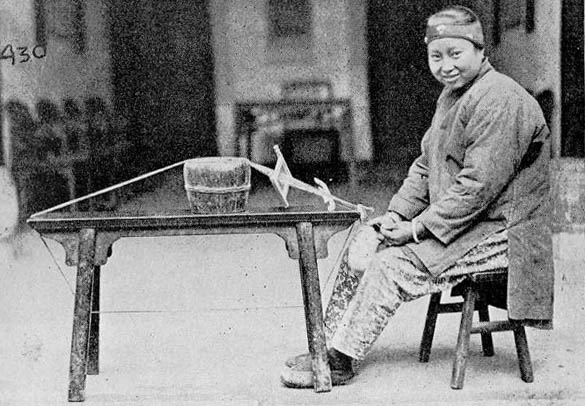

|
Making cloth was women's work in China. In early times, the two main fabrics were silk and hemp, supplemented by other fibers such as ramie. Beginning in Song times, cotton began to supplant hemp for ordinary clothes, and by Ming times cotton spinning and weaving were important cottage industries.
Silk, the most valued of all fabrics, was made in China from Shang times, if not earlier. Silk makes excellent clothing because it is soft, sheer, lightweight, long-lasting, and can be dyed brilliant colors. It can be made light enough to wear on the hottest of days, but also helps protect against the cold because silk floss makes excellent padding. By the Warring States period, Chinese were making multi-colored brocades and open-work gauzes as well as elaborate silk embroideries. |
|
|
|
Wang Juzheng, The Spinning Wheel, detail (Song)
|
||
|
|
||
|
Detail from illustrations of the sericulture process
|
||
|
From Song times on, cotton became the dominant fiber for ordinary clothes, though hemp and ramie also remained in use. The advantages of cotton were that it was lighter, warmer, and softer than these other fibers. Growing cotton plants was farm work, done primarily by men in areas where the climate and soil were favorable. However, many families that did not grow their own cotton bought unprocessed cotton that they spun themselves, or bought cotton yarn that they wove themselves. Thus, it was very common for women to spin and weave for their families, and in many parts of the country, they also produced for the market.
|
||

Spinning cotton is a demanding task. The spinner has to draw out uniform amounts of the short fibers as she spins so that they can be twisted into a thin, even thread.
What is this woman doing with her feet? |
||
|
Woman working a spinning wheel
|
||
| Cotton was generally woven into simple, flat weaves, using looms like the treadle loom used to weave silk. The loom used by the woman below was much simpler to make and set up. | ||

|
||
|
Woman weaving a band or ribbon on a small loom
|
||
| Women in well-to-do households by
late Imperial times rarely spun and wove, but needlework was considered a
proper occupation for women, and many women spent long hours making lace
or doing embroidery. The women below are making lace, perhaps solely
for their own use, perhaps to sell.
|
||
|
Women and children sitting on a kang, making lace
|
||

As seen earlier, many better-off women wore garments embellished with embroidery. (To review, click here.)
How much time do you think it would have taken to do the embroidery on this woman's gown? |
||
|
Embroidered silk women's dress
Move on to Twentieth Century Changes |
||